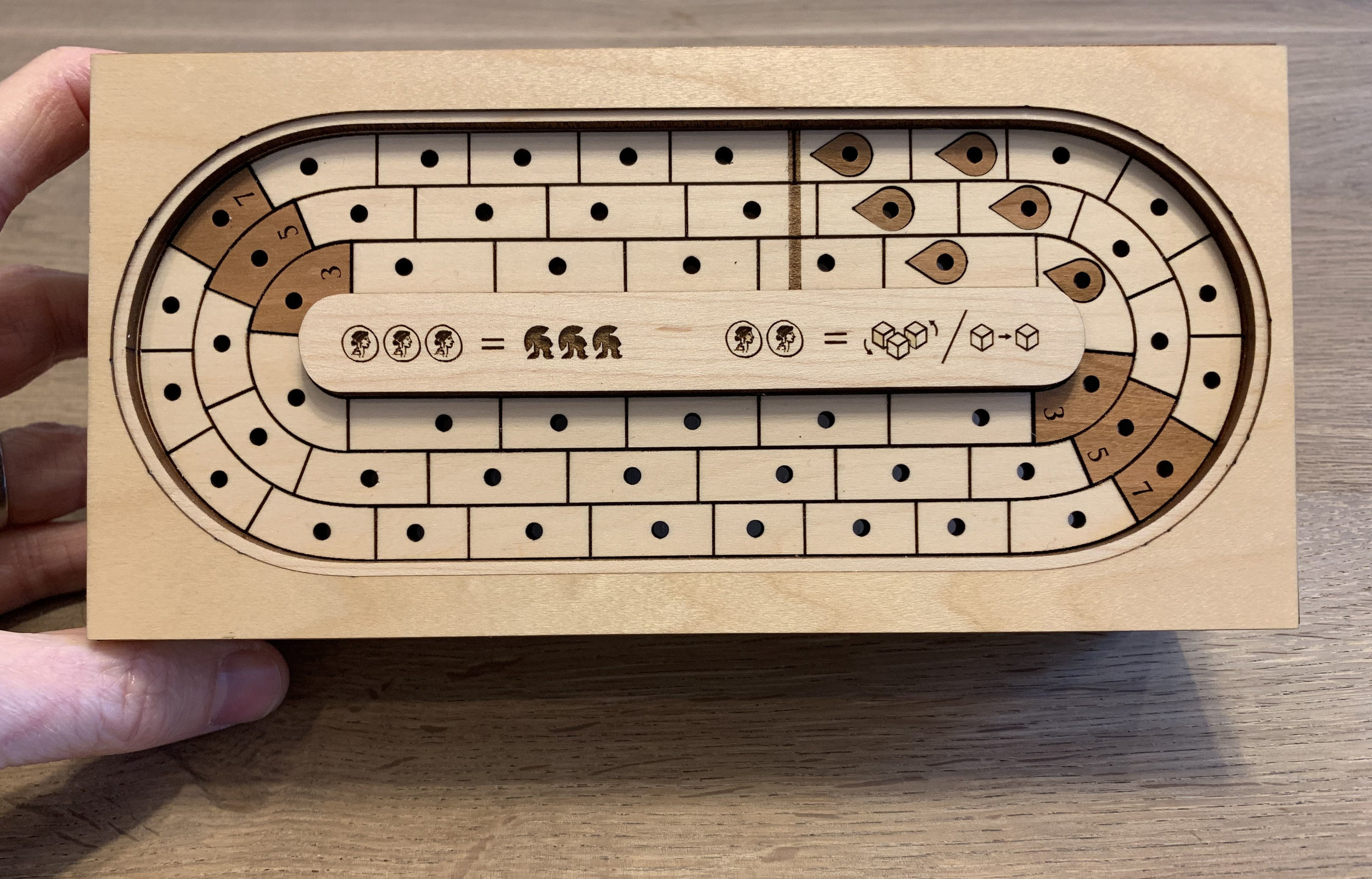For some reason, I love pegboards. I think it has something to do with the satisfying way that a wooden peg bites into a wooden board—they feel great to handle. I was fascinated with cribbage boards as a kid and remember being disappointed when I learned that they were only glorified scoring tracks. My game, Chariot Race grew out of a desire to make a simple race game out of a similar pegboard.
That was part of the pitch anyway, when I signed the game with Pegasus back in 2014. Unfortunately, when we developed it, costs for doing the game in wood were prohibitive, and when the game came out in 2016 it never had the table presence that I’d hoped it would. (If you’re curious, I’ve written up more on how the game evolved given those constraints.)
Enter the laser cutter. A few years ago, I helped crowd fund the Glowforge and it finally arrived last March. I had no idea I would use this thing so much. I’ll write up another post on how I’ve been using it for prototyping extensively (everything from the ERA games to Pandemic Legacy: Season 3 and more), but to start, I thought I’d share my most recent creation.
After a couple rounds of prototyping in baltic birch, here are photos of the final result, crafted in maple, cherry, poplar, and walnut. The only thing I’ve kept from the Pegasus edition is the wooden dice.
The board sits on top of a box that holds the dice, six chariot boards, and a drawer that contains the pegs and caltrops for up to six players to play. It all packs up all nice and tight.
The drawer holds pegs for six players plus all the caltrops you’d ever need.
Everything tucked away
The chariot pegboards
The drawer and chariot boards all pull from the same side of the box.
On the reverse, the dice sit in their own compartment.
Pulling the walnut slider open grants access to the dice.
Each chariot pegboard has a unique combination of cherry, maple, and/or poplar. This is the cherry/poplar combination.
Here are the box pieces laid out. The interior is made of baltic birch and I used maple laminate for the top and each side. I inlaid cherry for the corners and starting spaces and used walnut for the caltrops and for the door to the dice compartment. The track itself is cut from basswood as I liked how uniform the color was and how easily it took the pegs and caltrops.
All the components
Top view of the track
I’ve finally scratched this itch now that I have my own wooden set. I just have to remind myself how much work this was every time I’m tempted to make another one. (I don’t have any current plans on creating these for sale!) If you are a crafter though, and would like a copy of the .svg plans (for personal use only) drop me a line.
Here’s my machine, right before I plugged it in for the first time last March.
Glowforge Plug
I can’t say enough good things about the Glowforge. It’s well designed and easy to use – to the point where it’s nearly as simple as sending a job to your desktop printer. It sets up quickly and requires very little maintenance. Cutting components on it has become an integral part of my prototyping workflow. It’s wonderful for anything round or irregular (think: round, chipboard tokens) and is precise enough that I can use it to cut stickers (but not the backing!) from sticker sheets with hairline precision.
They’re not cheap, coming in between $2,400 (for the Basic) and $6,000 (for the Pro). I picked up the Plus which currently sells for about $4,000. I recommend it as a great midrange product.
If you do decide to take the plunge, you can save some cash ($100–$500) by using this referral link: https://glowforge.us/r/kUGE8V. (Disclosure: they’ll kick back the same amount to me in credits that I can spend on materials.) The one thing that can be a bit tricky is that you have to vent them outside. They offer an air filter for another $1000 (so you don’t need to vent) but the filters have been backordered for over a year now. I’ve been venting mine out the mail slot of my garage until my filter arrives.
In a future post, I’ll share images of the ERA: Medieval Age prototype that I created on the machine. It’s hard for me to imagine creating, developing, and testing the final version of that game without this cutter.












